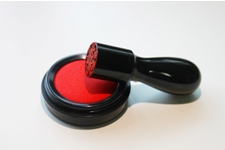The History of Insho
- Published 2010.7.13

It is said that the insho was first used over 5000 years ago by Mesopotamian civilizations. At first the insho was shaped like a flat stamp, but later changed into a cylinder. Pictures and letters were carved into the cylinder stones or horns, and then rolled onto a clay board, therefore leaving impressions of what was carved in the clay. These cylinder insho were used as tools of authentication, of course, but also were considered a symbol of power and authority.
Insho travelled from Mesopotamia through Egype, Indus, and on to China.
The oldest validated insho right now is one from the Warring States Period.
The insho system was established in China 2200 years ago, during the Qin era, when Qin Shi Huang was emperor. At that time, they were made mainly out of bronze.
During the Han dynasty, insho because much more popular, to the point where the Chinese emperor sent them out as gifts to kings of other countries.
The oldest insho in Japan is said to be a golden stamp called kan no na no wa no kokuou (µ╝óÕ¦öÕź┤ÕøĮńÄŗ). It was found at an archaeological site on Shikanoshima Island (Currently Fukuoka City) in 1784. Treated as a national treasure, it in on display at the Fukuoka City Museum. It has a length and width of 23 mm and a thickness of 8 mm, which becomes 23 mm once the handle has been inserted. There are records remaining that say that it was awarded by Emperor Guangwu of the Eastern Han Dynasty in 57 A.D.
The insho system was founded in Japan at the same time that the ritsuryo system (ancient East Asian system of centralized government) was established after the Taika reform of 645 A.D. The first insho were used as seals for official documents.
In the middle ages, a signature called kao became more popular to use, and for a period of time the insho system became out-of-date. It was not until the warring states period that insho made a recovery amongst military commanders. It is said that Oda Nobunaga and other daimyos used insho that were excessively individual to show off their power.
Upon entering the Edo Period it became normal for common people to use insho. They were not just limited to official documents, but were also used for private documents as well. In order to keep track of the various insho, the Inkan Cho (ÕŹ░ķææÕĖ│ lit. Inkan Register) was made. This Inkan Cho is said to be the prototype of the current inkan registration system.
The arrival of the Meiji Period came with more and more people using inkan. Due to a decree of the cabinet on October 1st, 1873, any official documents that were not stamped with a jitsuŌĆÖin were not to be considered valid by court of law. From this point forward, the jitsuŌĆÖin principle was determined, and the registration system was established. To mark this day, October 1st is called Insho no Hi, or ŌĆ£Insho Day.ŌĆØ
The Meiji government attempted to introduce a signature system, like those of western countries, at the same time as they did the insho system, but this ended in failure. To this day, it has become a custom to value insho more than a signature.
